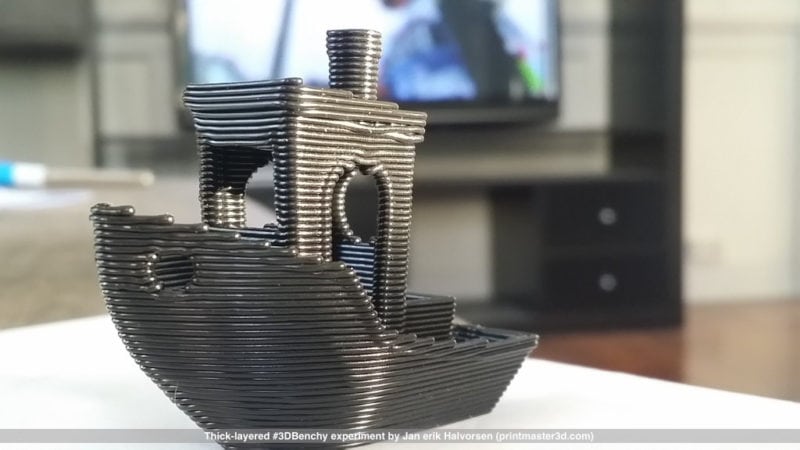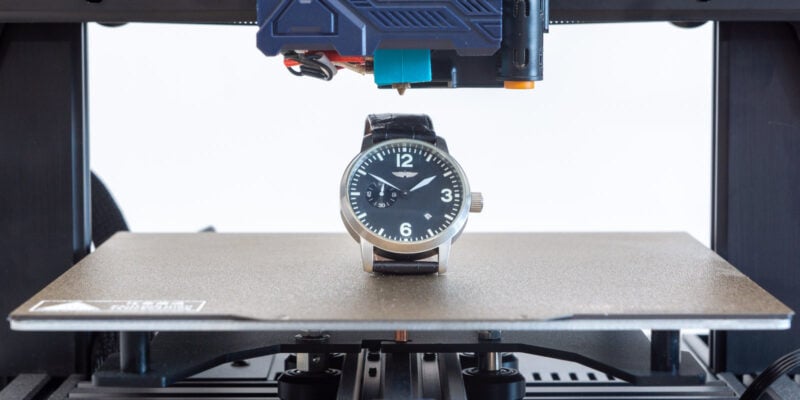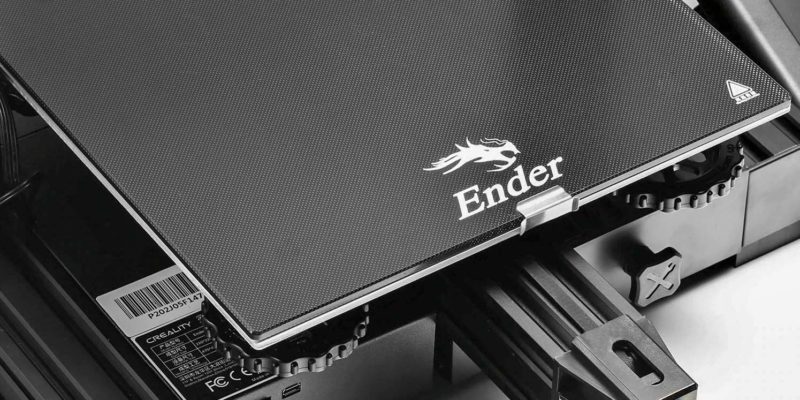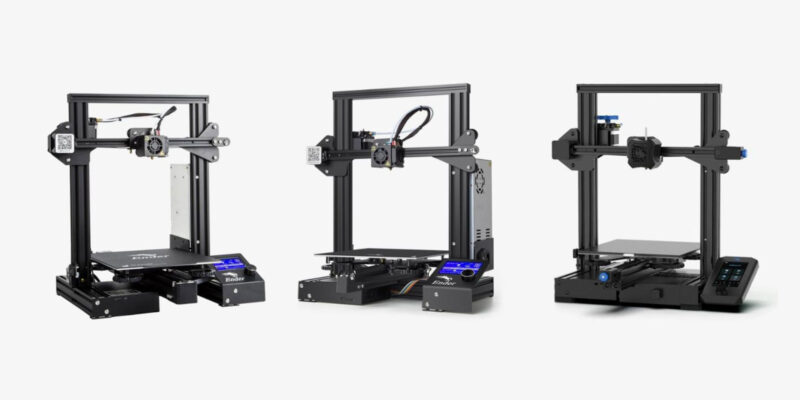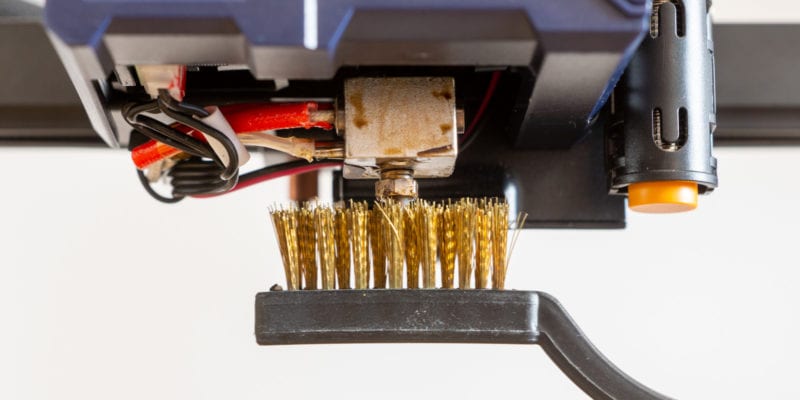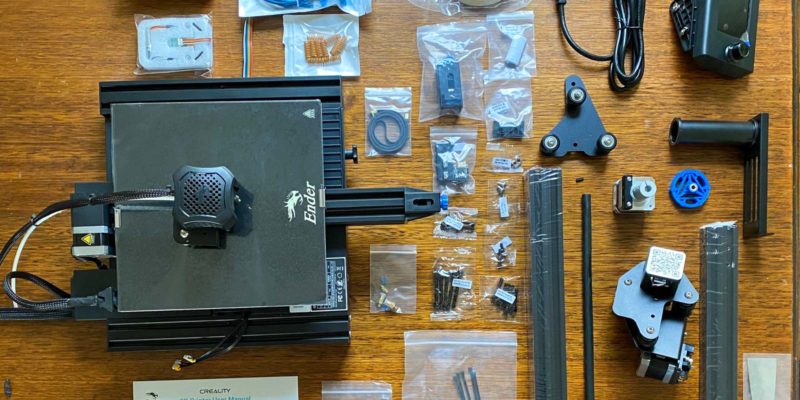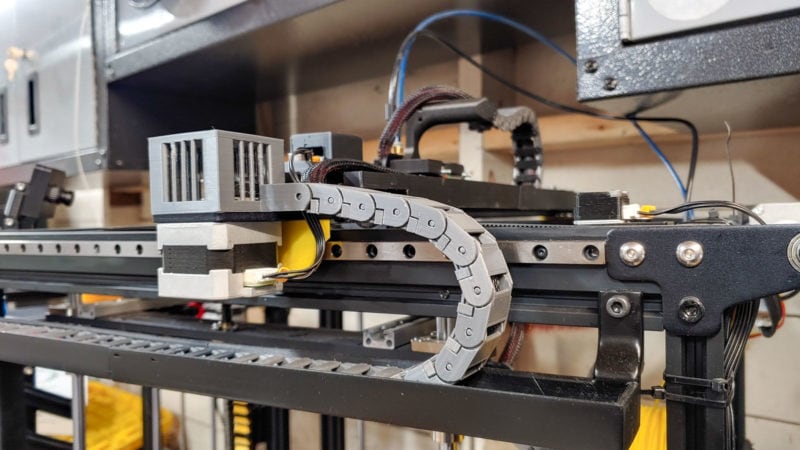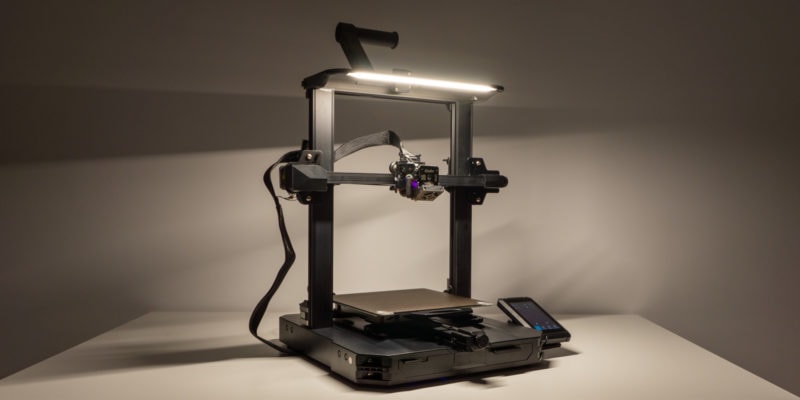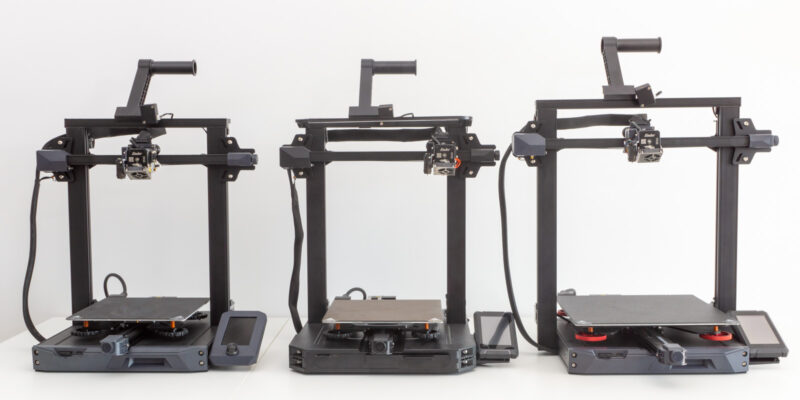The Creality Ender 3 is one of the best budget 3D printers you can buy right now. Creality further enhanced its simple design by introducing the Ender 3 V2 and the Ender 3 Pro. However, despite the other features, the one thing that remains the same in all the Ender 3s is their nozzle arrangement.
The Ender 3 (Pro / V2) uses an MK8 hot end type known for its simple design and open-source nature. The brass nozzle on the Ender 3 (Pro / V2) has a nozzle diameter of 0.4 mm. It is one of the most popular nozzle designs in the 3D printing community due to its low cost and ability to easily print a wide variety of materials.
In this article, we’ll understand more about the Ender 3 nozzle size and how it affects your overall 3D printing experience.
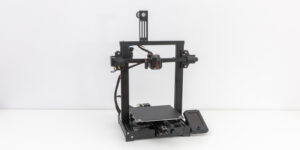
Stock Ender 3 Nozzle Size
The Creality Ender 3 nozzle has a diameter of 0.4 mm and comes with an M6 thread that’s fitted in an MK8 hot end design. Brass as a material is excellent for use in a 3D printer nozzle due to its excellent thermal conductivity, corrosion-resistant properties, easy machinability, and low cost.
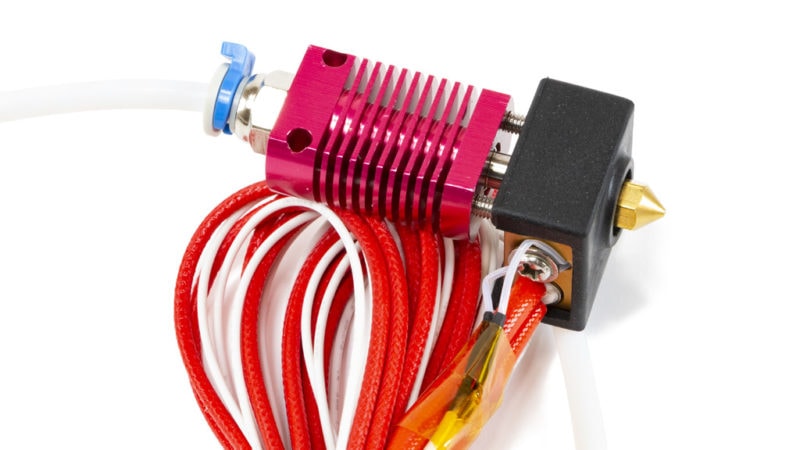
The 0.4 mm nozzle diameter, too, provides a great middle-ground between print quality and speed. You can print layers with a height as small as 0.12 mm and as high as 0.28 mm.
Moreover, the 0.4 mm Ender 3 nozzle size lets any minor dust particulates or filament impurities pass through it quickly, thus reducing the chances of nozzle clogging.
However, the drawback of the stock nozzle is that Brass is a soft material. Hence, you’re not able to print abrasive filaments with it. And you’ll also find that the 0.4 mm nozzle size restricts you from 3D printing highly detailed prints or larger prints with thicker layer heights.
So while the stock configuration might be great for a wide variety of 3D prints, if you want to 3D print miniatures or larger-sized objects, you will have to change the stock Creality Ender 3 nozzle.
Let’s look at the pros and cons of upgrading the Ender 3 stock nozzle size.
Is Bigger Always Better?
A bigger nozzle would mean anything larger than the stock 0.4 mm nozzle diameter. For the Creality Ender 3, the commonly available larger nozzle sizes are 0.6 mm, 0.8 mm, and 1.0 mm diameter. But does a bigger nozzle size lead to a better 3D printing output?
Thick Layers and Stronger Prints
With a larger diameter nozzle, you’ll be able to print models with a larger layer height and layers that are wider than usual. This leads to fewer layers and faster print speeds. On a large 3D printer, this is especially useful, as it shortens print time.
Additionally, a 3D print with thicker layers will be stronger when compared to a model having a low layer height because each layer will have more surface area to adhere to the next or previous one.
Thicker layers also mean prominent and visible layers. A larger nozzle size will produce higher layer height resulting in evident layers. In some situations, this is an unwanted effect, but you can also use it to your advantage. For example, you can print beautiful vases when 3D printing with thick layers in vase mode.
Another side effect of using larger nozzles on the Ender 3 is that they reduce your XY resolution, making it impossible to reproduce a model’s finer details.
Hot End Capacity
A larger 3D printer nozzle size translates to a higher filament flow through the hot end. You will need more heat to melt the filament in the heat break and push it through the bigger nozzle size. The Creality Ender 3’s stock hot end is not designed to push out high volumes of filament through it. To print with bigger nozzles, you will need to print at slower speeds.
If you want to print bigger objects and do not care about the layer lines, you can shift to a larger nozzle size on your Ender 3. Nozzles with 0.6 mm and 0.8 mm diameters are likely to meet most of your needs. The 1.0 mm nozzle size might be too much for the stock Ender 3 setup and you’ll have to significantly reduce your print speed to be able to melt all that plastic before it leaves the extrusion nozzle.
Smaller Ender 3 Nozzle, Better Quality?

If a bigger nozzle size leads to stronger prints and reduced print times, a smaller 3D printer nozzle size gives you a higher print quality and reproduces finer details easily. Typical smaller nozzle sizes are 0.3 mm, 0.2 mm, and 0.1 mm that you can use with the Ender 3.
Increased Print Quality
A thumb rule in 3D printing is to print at about 50% layer height of your nozzle diameter to get the best quality. When you apply this to the smaller 0.1 and 0.2 mm nozzles, you end up with thin layer heights of 0.08 – 0.15 mm. These finer layer lines result in an excellent surface finish and a great overall print quality.
These layer heights and level of details are generally as high as you can push an FDM 3D printer. If you want to go further, resin 3D printers are the only option.

Smaller nozzle sizes can better reproduce the minute features of your model’s design. It comes in handy when you decide to print miniatures, figurines, busts, and models with intricate and complex designs.
Clogging and Slow Speeds
As a downside, smaller nozzles are more prone to clogging. Small dust particles or impurities can easily jam the nozzle, leading to print failures. This results in more maintenance time, and you will have to ensure a clean and dust-free printing environment and use the best Ender 3 filament.
A smaller nozzle size also means smaller layer heights and less filament output. The smaller layer heights mean you’ll need more layers for a 3D print, which directly increases print times.
Reduced nozzle sizes are best if you’re printing small batches of miniatures or other small-sized objects that require high print quality. However, you need to be prepared for the slow print speeds, extra calibration time, and extra maintenance that come with using a smaller 3D printer nozzle on your Creality Ender 3.
Non-Brass Nozzles
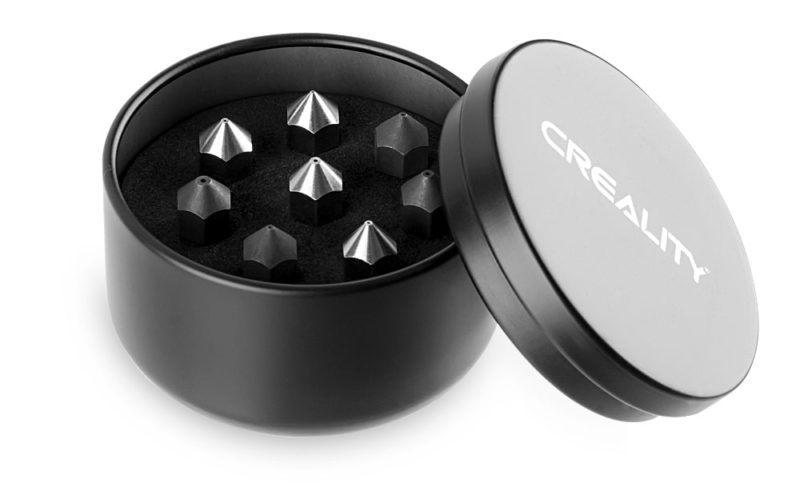
There are a lot of materials other than the standard PLA, ABS, and PETG. Metal-filled PLA, Nylon, wood filaments, glow-in-dark PLA, and even carbon fiber open up many applications. These materials make it easy to print long-lasting end-use components and rigid prototypes.
However, the Creality Ender 3’s stock brass nozzle material is not usable for abrasive filaments. They erode the brass and widen out the nozzle’s size over time, leading to inconsistent print results. The need for higher wear resistance is where alternate nozzle materials come into play.
For example, a steel 3D printer nozzle offers broad compatibility with many materials, offers high wear resistance, and is excellent for 3D printing abrasive filament materials. You can choose to either install a steel nozzle directly on the Ender 3’s stock hot end or upgrade to a high volume hot end such as the E3D V6.
Make sure to re-calibrate your 3D printer after changing to a different nozzle material. Testing temperatures with a temperature tower is always recommended.
In the table below we have summarized the 3D printer nozzle materials you can use with your Creality Ender 3 (Pro/V2) based on their individual properties and the filaments they can print.
| Material | Wear Resistance | Heat Transfer | Food Safe | Filaments |
|---|---|---|---|---|
| Brass | Low | High | No | Non-abrasive filaments |
| Stainless Steel | Medium | Low | Yes | Abrasive materials |
| Carbon Steel | High | High | Yes | Abrasive filaments |
| Tool Steel | High | High | Yes | Abrasive materials |
| Copper with ruby | Excellent | High | Yes | Abrasive filaments |
| Nozzle X | High | High | No | Abrasive materials |
What Nozzle is Best for the Ender 3?
There is no one-size-fits-all answer to this question, as the best nozzle for the Ender 3 will vary depending on your specific needs and preferences. However, some people find that a 0.4mm nozzle produces good results, while others prefer a 0.2mm or 0.3mm nozzle for more detail in their prints. Ultimately, it’s up to you to experiment with different nozzles and find the one that works best for you.
When Should I Replace My Ender 3 Nozzle?
The Ender 3 nozzle should be replaced when it starts to wear down and produce poor prints, or if the extruder stops feeding filament properly. You can also replace the nozzle to experiment with different print settings, such as changing the size of the nozzle opening to produce thicker or thinner layers.
How Long Does the Ender 3 Nozzle Last?
That depends on a few factors, such as the type of filament you’re using and the temperature you’re printing at. In general, it should last for a few hundred hours of printing if you are using non-abrasive filaments. However, if you’re noticing a drop in quality or performance, it’s time to replace the nozzle.
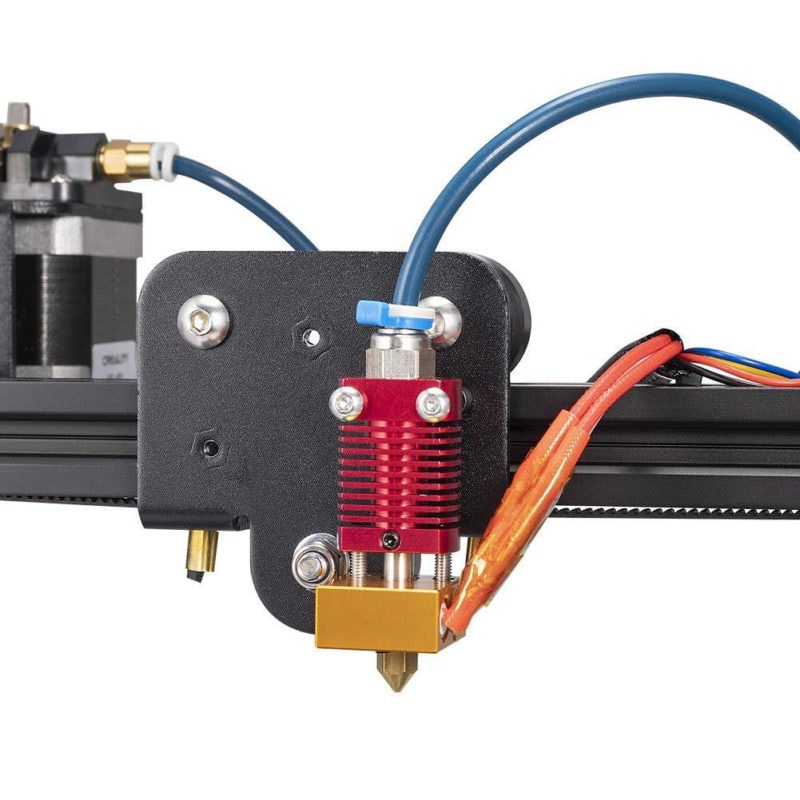
What Size Nozzles Come With the Ender 3 Pro?
The Ender 3 Pro comes with only a 0.4mm nozzle.
How Often Should I Clean the Ender 3 Nozzle?
It’s generally recommended to clean the nozzle every 5-10 prints, when you notice a decrease in quality, or when you change filaments.
Some people recommend cleaning the nozzle more often (every 3-5 prints), while others recommend cleaning it less often (every 10-15 prints). Ultimately, it depends on how much gunk and filament residue accumulates on the nozzle, and how much of a difference it makes in terms of print quality.
To clean the nozzle, use a small wire brush to scrub off any residue that might be blocking the hole. Be careful not to damage the nozzle while cleaning it. You can also use a compressed air gun to blow out any dirt or debris from inside the nozzle.
How Do You Unclog an Ender 3 Nozzle?
If your Ender 3 nozzle is clogged, there are a few things you can do to try and unclog it. First, try heating up the nozzle with a heat gun or hair dryer. This will sometimes soften the material that’s clogging the nozzle and allow it to be flushed out with compressed air. If that doesn’t work, you can try using a nozzle cleaning toolkit to pick out the clog. Be careful not to damage the nozzle in the process. Finally, if all else fails, you can replace the nozzle with a new one.
Are Creality Nozzles Any Good?
In general, Creality nozzles tend to be in the middle of the pack in terms of quality – not bad, but not great either. If you’re looking for a nozzle that will produce high-quality prints, it might be worth spending a bit more money on a nozzle from a higher-end brand like E3D.
Conclusion
The Creality Ender 3 (Pro/V2) series remain great 3D printers for the money and offer excellent value for beginner 3D printing needs. The 0.4 mm brass nozzle is ideal for heat transfer, price, and printing with non-abrasive filaments such as PLA and ABS. If you do want to print with more exotic filament types of an abrasive nature, you can use steel nozzles that offer high wear resistance to these materials.
Using larger nozzles with the Ender 3 will give you stronger parts and reduce your print times; however, it will result in reduced print quality.
On the other hand, smaller nozzle diameters will significantly improve your print quality. You can get prints comparable to prints produced via resin printing if you can tune everything. However, the drawback is a higher chance of a clogged nozzle and increased print times.
Always be sure to calibrate your 3D printer correctly for the best results with whichever nozzle size you decide to use.
Let us know your thoughts on the Creality Ender 3’s nozzle size and materials. If you have anything else that you’d like to ask, feel free to leave a comment below.




